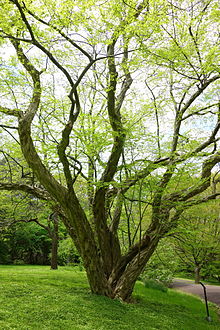
KNOWPIA
WELCOME TO KNOWPIA
Summary
Pteroceltis tatarinowii a species of tree endemic to China and the only extant member of the genus Pteroceltis.[1] Common names include blue sandalwood, wingceltis, Tatar-wingceltis or qing tan (Chinese: 青檀; pinyin: qīngtán). Trees grow to 20 m (66 ft) tall and are used for timber, the bark fiber to make Xuan paper, and oil is extracted from its seeds.[2] Seeds were collected and brought to America by Frank Meyer and given to the USDA in 1907. One of those seeds grew into a mature tree at the Morris Arboretum outside of Philadelphia, PA.
| Pteroceltis tatarinowii | |
|---|---|

| |
| Scientific classification | |
| Kingdom: | Plantae |
| Clade: | Tracheophytes |
| Clade: | Angiosperms |
| Clade: | Eudicots |
| Clade: | Rosids |
| Order: | Rosales |
| Family: | Cannabaceae |
| Genus: | Pteroceltis |
| Species: | P. tatarinowii
|
| Binomial name | |
| Pteroceltis tatarinowii Maxim.
| |
Gallery edit
-
Leaf detail of Pteroceltis tatarinowii.
-
Another view of the specimen at the Morris Arboretum.
-
A close-up including the sign with history of the tree.
-
Bark detail of Pteroceltis tatarinowii.
References edit
- ^ Zhang, Y.; Wang, G.; Zhou, J.; Zhou, X.; Li, P.; Wang, Z. (2019). "The first complete chloroplast genome sequence of Pteroceltis tatarinowii (Ulmaceae), an endangered tertiary relict tree endemic to China". Mitochondrial DNA Part B. 4: 487–488. doi:10.1080/23802359.2018.1544861.
- ^ "Introduction to the Xuan Paper Making in Anhui China". China Culture Tour.com. 2019. Retrieved 2019-12-17.
- Pteroceltis tatarinowii, Maximowicz, Bull. Acad. Imp. Sci. Saint-Pétersbourg. 18: 293. 1873.
- The Plant List entry
- eFloras entry
External links edit
- Media related to Pteroceltis tatarinowii at Wikimedia Commons


